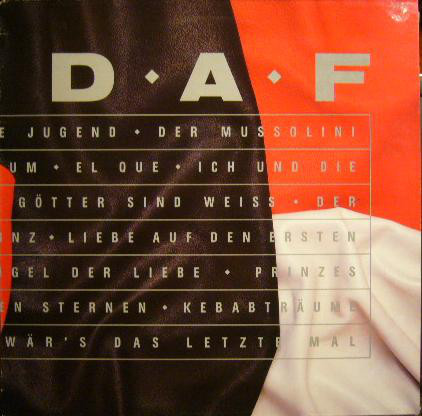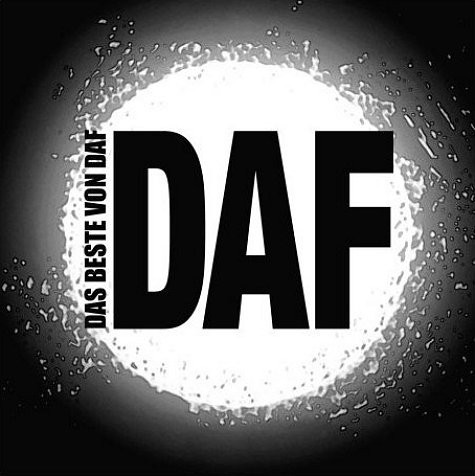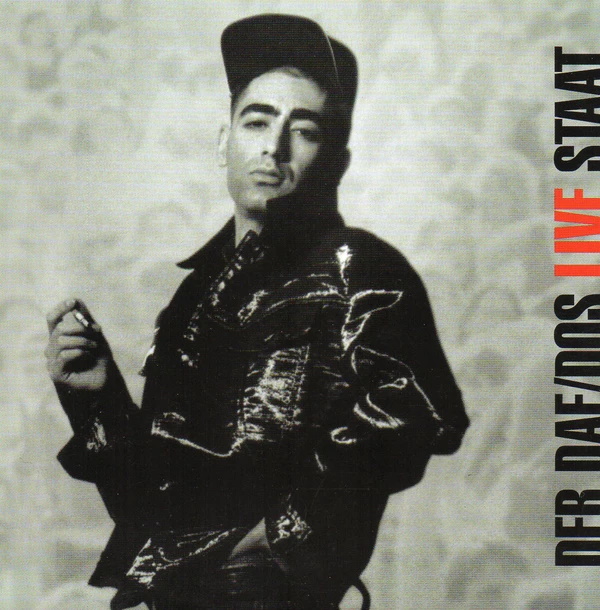Kollectiv
We’ve completed our chronological run through the DAF albums, but as ever at this point, I’ll run through the shortcuts available to those of you still collecting physical formats. The first D.A.F. compilation was issued by Virgin in 1988, simply titled D.A.F. Focusing solely on the three albums the label released themselves, it’s got everything the casual fan would want to hear, plus a couple of remixes – both of which were released as singles to promote the collection. The new version “Der Mussolini” is only a slight tweaked version of a tune that really didn’t have scope for further improvement, whilst “Liebe Auf Den Ersten Blick” is stretched out to six minutes – maybe handy for DJs, but if you’re just here to listen, stick to the original.
Mute eventually obtained the rights to DAF’s early 80s catalogue in the late 1990s, which is why many of the later versions of the albums referred to up until now “The Virgin Trilogy” were actually issued on Daniel Miller’s reissue sublabel “The Grey Area”. Mute eventually put out their own compilation Das Beste Von DAF. Again built solely around the same trio of albums, it’s a longer but weaker compilation, including some of the lesser tracks from the trilogy whilst omitting earlier notable songs like “Coco Pino” – and they couldn’t get the rights to more recent tunes like “Der Sheriff” either.
If you’re in the market for this, you might as well go the whole hog and seek out the lengthy box set Das Ist DAF from 2017 on German label Grönland Records. Offering Die Kleinen Und Die Bösen alongside the ‘big three’ in LP, CD or FLAC form, it’s almost all the DAF you could ever want – like Mute, Grönland couldn’t seem to get the rights to their 2003 comeback album, and no-one seems to care about curating their house and techno material at this point. Even I had to force myself to write about it, and that’s only because I don’t let lesser works remain buried.
Misc
DAF never released a full blown live album – the closest they got being the ‘accidental’ second half of their 1980 Mute debut. This is possibly understandable – for the most part, their songs didn’t change that much when they took them onto the stage. That said, there might have been value in capturing the occasional track from ‘Die Kleinen Und Die Bösen’ without guitars, or a couple of the ‘Fünfzehn neue DAF Lieder’ with live drums. If you want to know what these were like, you’ll have to resort to YouTube videos, as they never released a DVD either.
For reasons that must have been clear at the time, offshoot DAF/DOS did release a stage recording in the form Der DAF/DOS Live Staat, featuring live versions of some of their albums tracks plus several compositions that never made it onto their studio records. None of the exclusive tracks are in any way exceptional, similar to those we’ve already heard. I picked this up for 3 Euros from a festival market bargain bin and only dug it up again to write this, which is a fair indication of how much impact it had.
Another thing that usually crops up at this point in these guides is the remix collection. As previously established, DAF only occasionally used 3rd party remixers on their singles, and their in-house mixes were only slight variations on their themes. It took until 2018 for the Reworx EP to appear, their first and only remix collection – and even here, both Robert and Gabi contribute to the mixing alongside dance scene heavyweights Giorgio Moroder, Westbam and Boys Noize.
Other than a rather ponderous minimal mix of “Goldenes Spielzeug” that’s just shy of nine minutes in length, the mixes all follow the simple pattern of combining loops from the original tunes with contemporary dance beats and production methodologies. As ever with remix collections, you’ll gravitate to whichever remixer practices your dance genre of choice. In my case, Moroder and Naidanov’s uncomplicated take on “Mussolini” would be my go-to should I ever find myself accidentally booked to play EDM instead of EBM.
And therein lies the lesson – these songs never needed radical reconstruction to remain contemporary. Throughout this piece, I’ve made reference to genres such as industrial, synthpop and electroclash. But that’s just me making a connection to things I know. In reality, virtually all forms of danceable electronic music owe something to the DAF concept of hitting upon simple-but-effective loops and phrases and developing them from there.
Fellow Düsseldorfers Kraftwerk usually get most of the credit for this concept, but relatively few electronic musicians ever had the luxury of Kling Klang levels of equipment and the achingly slow production process required to get the most out of that much machinery. DAF proved you could do it with a couple of inexpensive synths and a stack of good ideas. The fact that they later tried to claw back some of the dancefloor influence for themselves later in their career with mixed results at best does not matter in the grand scheme of things. History shows us that they got there first.




